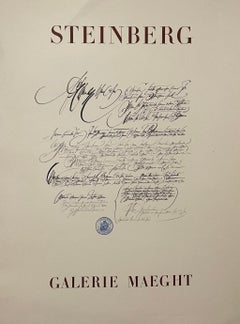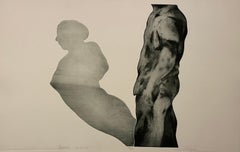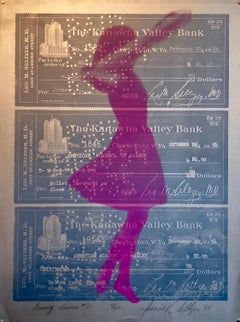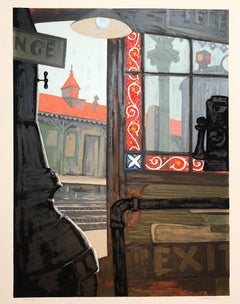Want more images or videos?
Request additional images or videos from the seller
1 of 12
James DarumNative American Indian Family, Old Southwest Silkscreen Serigraph James Darum
Price:$430
$500List Price
About the Item
- Creator:James Darum (American)
- Dimensions:Height: 30 in (76.2 cm)Width: 24.25 in (61.6 cm)
- Medium:
- Movement & Style:
- Period:
- Condition:good. light crack in one area in silkscreen paint.
- Gallery Location:Surfside, FL
- Reference Number:1stDibs: LU3824179891
About the Seller
4.9
Platinum Seller
Premium sellers with a 4.7+ rating and 24-hour response times
Established in 1995
1stDibs seller since 2014
1,843 sales on 1stDibs
Typical response time: 1 hour
Authenticity Guarantee
In the unlikely event there’s an issue with an item’s authenticity, contact us within 1 year for a full refund. DetailsMoney-Back Guarantee
If your item is not as described, is damaged in transit, or does not arrive, contact us within 7 days for a full refund. Details24-Hour Cancellation
You have a 24-hour grace period in which to reconsider your purchase, with no questions asked.Vetted Professional Sellers
Our world-class sellers must adhere to strict standards for service and quality, maintaining the integrity of our listings.Price-Match Guarantee
If you find that a seller listed the same item for a lower price elsewhere, we’ll match it.Trusted Global Delivery
Our best-in-class carrier network provides specialized shipping options worldwide, including custom delivery.You May Also Like
Ratfinkbonerthunk : Surrealist Rat - Original Giclee Print, Handsigned
By Kenny Scharf
Located in Paris, IDF
Kenny Scharf
Ratfinkbonerthunk : Surrealist Rat, 1990
Original Giclee Print
Handsigned in pencil
On Arches vellum 56 x 76 cm (c. 22 x 30 in)
Published by Editions Vermorel in 1990
...
Category
1990s American Modern Figurative Prints
Materials
Giclée, Screen
$1,794
H 22.05 in W 29.93 in
Interlude, Screenprint by Will Barnet
By Will Barnet
Located in Long Island City, NY
Artist: Will Barnet, American (1911 - 2012)
Title: Interlude
Year: 1982
Medium: Serigraph, signed and numbered in pencil
Edition: AP
Image Size: 20 x 38 inches
Size: 25.5 x 42.5 in. (64.77 x 107.95 cm)
Fig 179, pg 70 from Will Barnet: Prints 1931-2005, published by John Szoke...
Category
1980s American Modern Figurative Prints
Materials
Screen
Circe 2
By Will Barnet
Located in San Francisco, CA
This artwork titled "Circe" 1979 is an original colors serigraph on Wove paper by noted American artist Will Barnet, 1911-2012. It is hand signed, titled and numbered 43/100 in pencil by the artist. The image size (circle) is 18 x 18 inches, sheet size is 23.25 x 24 inches. It is in excellent condition, has never been framed.
About the artist:
Born in 1911 in Beverly, Massachusetts, Barnet knew by the age of ten that he wanted to be an artist. As a student, he studied with Philip Leslie Hale at the School of the Museum of Fine Arts, Boston and viewed first-hand John Singer Sargent at work on the murals of the Boston Public Library. In 1930, Barnet studied at the Art Students League of New York, with Stuart Davis and Charles Locke, beginning his long association with the school. Here he concentrated on painting as well as printmaking, and, in 1936, he became the official printer for the Art Students League. There, he later instructed students in the graphic arts at the school and taught alongside the likes of Yasuo Kuniyoshi, Robert Beverly Hale and Richard Pousette-Dart. Barnet influenced a generation of artists, including James Rosenquist, Knox Martin, Emil Milan, Paul Jenkins, Ethel Fisher...
Category
Late 20th Century American Modern Figurative Prints
Materials
Screen
Headstand (San Francisco Museum of Modern Art) - Exhibition Poster
By Keith Haring
Located in Paris, IDF
Keith Haring
Headstand
Original vintage exhibition Poster printed in Screenprint
On thick paper
90 x 60 cm (c. 36 x 24 in)
INFORMATION: Official screenprint poster for the Haring e...
Category
1980s American Modern Figurative Prints
Materials
Screen
"Dodge Rebellion Girls" - 1967 Original Silkscreen on Paper Artists Proof
By Marc Foster Grant
Located in Soquel, CA
"Dodge Rebellion Girls" - 1967 Silkscreen on Paper
1967 color silkscreen depicting the Dodge Rebellion Girls by Marc Foster Grant (American, b. 1947). A silhouette of the 'dodge gi...
Category
1960s American Modern Figurative Prints
Materials
Paper, Ink, Screen
$760 Sale Price
20% Off
H 22 in W 32 in D 0.5 in
"Metropolitan Opera, New York City Premiere" Large serigraph.
By LeRoy Neiman
Located in San Francisco, CA
This artwork titled "Metropolitan Opera, New York City, Premiere" 1980 is an original colors serigraph by noted American artist LeRoy Neiman, 1921-2012. It is hand signed and numbere...
Category
Late 20th Century American Modern Figurative Prints
Materials
Screen
$4,500
H 36 in W 52 in D 1.35 in
Rama Rama 1971 Signed Limited Edition Screenprint
By Peter Max
Located in Rochester Hills, MI
Artist: Peter Max
Title: Rama Rama
Year: 1971
Medium: Screenprint
Edition: Signed in pencil and marked 72/100
Very good unframed condition.
Beginning in the 1960s Peter Max has bee...
Category
1970s American Modern Figurative Prints
Materials
Screen
Original British Columbia United Air Lines travel poster
Located in Spokane, WA
Behold the original British Columbia United Air Lines vintage Travel Poster—a rare gem from the mid-century Modern era. This archival linen-backed beauty is in excellent condition an...
Category
1960s American Modern Figurative Prints
Materials
Screen
"Equal Justice Under Law" Screenprint #99/125 on Wove Paper
By Robert Rauschenberg
Located in Soquel, CA
"Equal Justice Under Law" Screenprint #99/125 on Wove Paper
Iconic composition by Robert Rauschenberg (American, 1925-2008). A red envelope and a hand holding sprouted grass the pli...
Category
1970s American Modern Abstract Prints
Materials
Laid Paper, Screen
$5,000
H 34 in W 26.5 in D 1.25 in
Jazz : Swing Guy (Yellow) - Screenprint Poster, Montreux, 1983
By Keith Haring
Located in Paris, IDF
Keith Haring
Swing Guy (Yellow), 1983
Screenprint
Printed signature in the plate
On heavy paper 100 x 70 cm (c. 40 x 28 in)
Created by Haring for the Montreux Jazz Festival
Excelle...
Category
1980s American Modern Figurative Prints
Materials
Screen
$717
H 39.38 in W 27.56 in
More From This Seller
View AllVintage Poster Saul Steinberg Galerie Maeght Paris France
By Saul Steinberg
Located in Surfside, FL
SAUL STEINBERG (American 1914-1999) Via Air Mail Geometric Design Lithograph. Sheet: 21 1/2 x 28 inches; Frame: 22 1/4 x 29 inches. Plate signed and dated l/r with sticker upper ri...
Category
1970s American Modern Figurative Prints
Materials
Screen
Modernist Figurative Pop Art Etching and Aquatint "the Artist" Michael Mazur
By Michael Mazur
Located in Surfside, FL
Michael Mazur
"The Artist"
Hand signed and editioned from the edition of 50
1967
Michael Burton Mazur (1935-August 18, 2009) was an American artist who was described by William Grim...
Category
Early 2000s American Modern Abstract Prints
Materials
Lithograph, Screen
1970s Pop Art "Dancing Lessons #2" Silver Silkscreen Mod Ballet Girl Print
By Joanne Seltzer
Located in Surfside, FL
Printed on a slightly reflective metallic silver finished paper. there is a companion piece on a money green paper. A depiction of a ballet dancer, superimposed upon canceled dance c...
Category
1970s American Modern Portrait Prints
Materials
Screen
Modernist Silkscreen Screenprint 'El Station, Interior' NYC Subway, WPA Artist
By Anthony Velonis
Located in Surfside, FL
screenprint printed in color ink on wove paper. New York City subway station interior.
Anthony Velonis (1911 – 1997) was an American painter and designer born in New York City who helped introduce the public to silkscreen printing in the early 20th century.
While employed under the federal Works Progress Administration, WPA during the Great Depression, Velonis brought the use of silkscreen printing as a fine art form, referred to as the "serigraph," into the mainstream. By his own request, he was not publicly credited for coining the term.
He experimented and mastered techniques to print on a wide variety of materials, such as glass, plastics, and metal, thereby expanding the field. In the mid to late 20th century, the silkscreen technique became popular among other artists such as Robert Rauschenberg and Andy Warhol.
Velonis was born into a relatively poor background of a Greek immigrant family and grew up in the tenements of New York City. Early on, he took creative inspiration from figures in his life such as his grandfather, an immigrant from the mountains in Greece, who was "an ecclesiastical painter, on Byzantine style." Velonis attended James Monroe High School in The Bronx, where he took on minor artistic roles such as the illustration of his high school yearbook. He eventually received a scholarship to the NYU College of Fine Arts, into which he was both surprised and ecstatic to have been admitted. Around this time he took to painting, watercolor, and sculpture, as well as various other art forms, hoping to find a niche that fit. He attended NYU until 1929, when the Great Depression started in the United States after the stock market crash.
Around the year 1932, Velonis became interested in silk screen, together with fellow artist Fritz Brosius, and decided to investigate the practice. Working in his brother's sign shop, Velonis was able to master the silkscreen process. He reminisced in an interview three decades later that doing so was "plenty of fun," and that a lot of technology can be discovered through hard work, more so if it is worked on "little by little."
Velonis was hired by Mayor LaGuardia in 1934 to promote the work of New York's city government via posters publicizing city projects. One such project required him to go on a commercial fishing trip to locations including New Bedford and Nantucket for a fortnight, where he primarily took photographs and notes, and made sketches. Afterward, for a period of roughly six months, he was occupied with creating paintings from these records. During this trip, Velonis developed true respect and affinity for the fishermen with whom he traveled, "the relatively uneducated person," in his words.
Following this, Velonis began work with the Public Works of Art Project (PWAP), an offshoot of the Civil Works Administration (CWA), where he was assigned to serve the different city departments of New York. After the formation of the federal Works Progress Administration, which hired artists and sponsored projects in the arts, he also worked in theater.
Velonis began working for the federal WPA in 1935. He kept this position until 1936 or 1938, at which point he began working in the graphic art division of the Federal Art Project, which he ultimately led. Under various elements of the WPA program, many young artists, writers and actors gained employment that helped them survive during the Depression, as well as contributing works that created an artistic legacy for the country.
When interviewed in December 1994 by the Library of Congress about his time in the WPA, Velonis reflected that he had greatly enjoyed that period, saying that he liked the "excitement" and "meeting all the other artists with different points of view." He also said in a later interview that "the contact and the dialogue with all those artists and the work that took place was just invaluable." Among the young artists he hired was Edmond Casarella, who later developed an innovative technique using layered cardboard for woodcuts.
Velonis introduced silkscreen printing to the Poster Division of the WPA. As he recalled in a 1965 interview: "I suggested that the Poster division would be a lot more productive and useful if they had an auxiliary screen printing project that worked along with them. And apparently this was very favorably received..."
As a member of the Federal Art Project, a subdivision of the WPA, Velonis later approached the Public Use of Arts Committee (PUAC) for help in "propagandizing for art in the parks, in the subways, et cetera." Since the Federal Art Project could not be "self-promoting," an outside organization was required to advertise their art more extensively. During his employment with the Federal Art Project, Velonis created nine silkscreen posters for the federal government.
Around 1937-1939 Velonis wrote a pamphlet titled "Technical Problems of the Artist: Technique of the Silkscreen Process," which was distributed to art centers run by the WPA around the country. It was considered very influential in encouraging artists to try this relatively inexpensive technique and stimulated printmaking across the country.
In 1939, Velonis founded the Creative Printmakers Group, along with three others, including Hyman Warsager. They printed both their own works and those of other artists in their facility. This was considered the most important silkscreen shop of the period.
The next year, Velonis founded the National Serigraph Society. It started out with relatively small commercial projects, such as "rather fancy" Christmas cards that were sold to many of the upscale Fifth Avenue shops...
Category
1980s American Modern Figurative Prints
Materials
Screen
1970s Pop Art "Dancing Lessons #2" Green, Pink Silkscreen Mod Ballet Girl Print
By Joanne Seltzer
Located in Surfside, FL
there is a companion piece on a silver paper. A depiction of a ballet dancer, superimposed upon canceled dance class checks.
Joanne Seltzer was born in Philadelphia, Pennsylvania a...
Category
1970s American Modern Abstract Prints
Materials
Screen
Large George Grosz 1923 Lithograph Die Rauber German Expressionism WPA Realism
By George Grosz
Located in Surfside, FL
From The robbers. lithographs by George Grosz for the drama of the same name.
photolithography on laid paper. 19 X 25.5 inches (sheet size). This is not hand signed or numbered in ...
Category
1930s American Modern Figurative Prints
Materials
Lithograph



